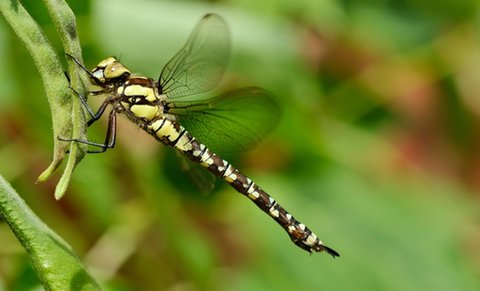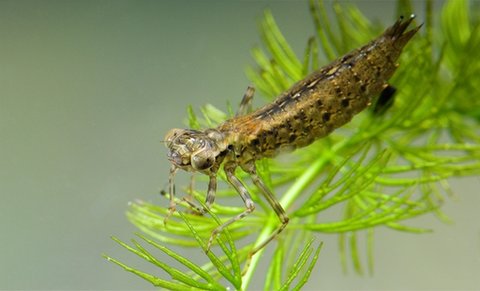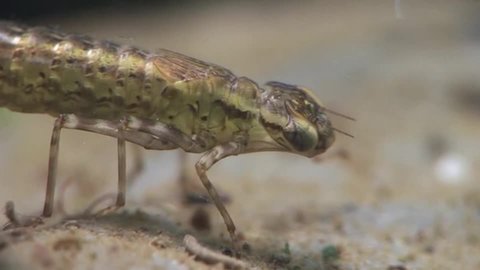
adult
dragonfly
Theolderversionhasthreebodysegments.Likeallinsects,ithasahead,thorax,andabdomen.Ithassixlegs.Ithastwopairsofwings.Itseyesareclosetogether.Theytouch.Anditsbodyisbrightly colored.

dragonfly nymph
Theyoungerversionalsohasthreebodysegments.Ithassixlegs,too.Butitswingshavenotyetformed.Itseyesarefarapart.Andit'snotas colorful.
Thisisthesameanimal.Itisthesouthernhawkerdragonfly.Youarejustseeingitatdifferentpointsinits life.
Lookatthemside-by-side.Theyaredifferentversionsofthesame thing!

InsectBody Parts
head
thorax
abdomen
ChangesAhead
Allinsectsexperienceaprocessofchange.Itiscalledmetamorphosis.Mostinsectshavewhatisknownasacompletemetamorphosis.Theirbodiesmovethroughfourstages.Egg.Larva.Pupa.Adult.Dragonflieshaveanincompletemetamorphosis.Theirbodiesonlygothroughthreestages.Egg.Nymph. Adult.
SouthernhawkersarecommoninEurope.Theylivenearsmallponds.Eachdragonflybeginslifeasan egg.
Malesandfemalesmateinlatesummer.Thefemalelayshereggsinsidewaterplants.Thiskeepsthemsafefrom predators.
Ayoungdragonflyhatchesinthespring.Ithasasharppointeronitshead.Itusesthistobreakitseggopen.Whatcomesoutiscalledaprolarva.Itfreesitselffromitscovering.Thenitentersthewaterandshedsitsskin,ormolts.It isnowa nymph.
Nymphsmustmoltmanytimesastheygrow.That’sbecausetheirouterlayer,orexoskeleton,cannotgrow.Whentheinsectgetstoobig,itsskinsplits open.

Asouthernhawkernymph'sbodyisbrownandgreen.Thesecolorsmakethenymphhardertoseein the water.
A southernhawkernymphmoves underwater.
Deepbreathscausethesplittowiden.Thesouthernhawkerthenshrugsoutoftheoldskin.Nowthedragonflynymphisslightly larger.
Moltingishelpfulinanotherway.Itallowsdamagedtissuetoheal.Missinglimbscangrowagain.Yet,moltingcanbeadangeroustime.Itopensupthedragonflyto predators.
MoreMobile
Adragonflynymphcanzipthroughthewater.Itmovesbysquirtingwateroutofitsbackend.Thispropelsitforward.Thedragonflyneedstomovequickly.Itisalways hunting.
Thenymph’sbodyisbrownandgreen.Itblendsinwithpondorlakewater.It’shardforits predatorsorpreytoseeit.Butthenymphcansee them.
Itslargeeyesarealwaysscanningforprey.Thenymphneedstoeat.Itlooksforinsects,smalltadpoles,and fish.
Asouthernhawkernymph'seyesaresetfar apart.

